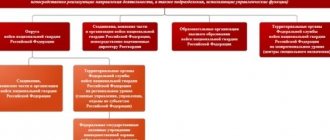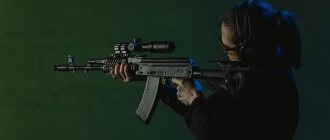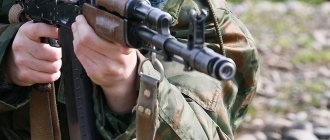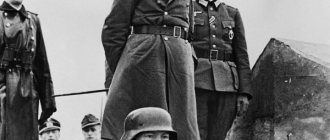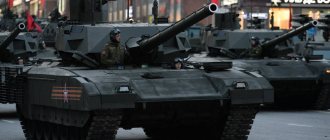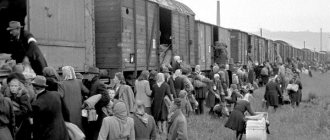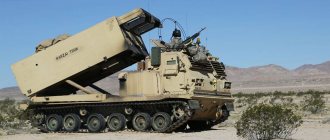On July 3, 2016, [1] Federal Law No. 226-FZ dated July 3, 2016 “On the Troops of the National Guard of the Russian Federation” (hereinafter referred to as Federal Law No. 226-FZ) came into force. This law defines the tasks of the troops of the National Guard of the Russian Federation, their composition, principles of activity and powers; issues regulating their leadership and management, staffing are disclosed; the procedure for providing social guarantees to military personnel of the Russian Guard troops, as well as the procedure for financial and logistical support for these troops, was considered. Let's take a closer look at the provisions of the new document.
Reactions and ratings
Official statements
On April 5, 2016, the press secretary of the Russian President Dmitry Peskov said that the creation of a national guard that would replace the Internal Troops of the Russian Ministry of Internal Affairs was not
associated with a crisis of confidence in other security agencies.
Assessments of military personnel and employees of the security forces of departments
The head of the Moscow trade union of police officers, Mikhail Pashkin, noted that the functions of the National Guard will partially coincide with the functions of the FSB of Russia, in particular in the tasks of combating terrorism.
Retired Major General of the FSB of Russia Vasily Eremenko suggested that the National Guard, unlike the FSB of Russia, will conduct large counter-terrorism operations within the country.
The former head of the Russian Ministry of Internal Affairs, Army General Anatoly Kulikov, said that the Russian Guard must fight radical terrorism.
According to the former Commander-in-Chief of the forces of the Donetsk People’s Republic, I. I. Strelkov, the created structure is a tool “and the benefit or harm from its use depends solely on who will use it.”
Opinions from opposition scholars, political commentators and public figures
Political observer K. Rogov said that the creation of the Russian Guard is a sign of a crisis in the power of V.V. Putin.
Historian A.I. Fursov, in his interview with the ANNA News TV channel, noted the discrepancy between the decision to create the National Guard of the Russian Federation and the existing problems and potential threats in the country.
According to orientalist A. A. Nemirovsky, the NG RF was created as a result of the aggravation of tensions in the Middle East region at the end of 2014 - beginning of 2015 and the next stage of deterioration in Russian-American relations.
Publicist M. Kalashnikov compared the newly created military formation with the Praetorian Guard of Ancient Rome.
Public figure Yu. Yu. Boldyrev expressed confidence that the NG RF was created to provide forceful cover for unpopular reforms in the social sector, in particular in the field of education and healthcare, as well as “Strategy 2020,” - in his opinion, senior officials Long before Russia's accession to the WTO, officials in the country predicted the emergence of a large number of people dissatisfied with these reforms and the need to oppose them with the consolidated forces of several departments to suppress any manifestations of public protest during the further implementation of this course of reforms.
Political scientist G. O. Pavlovsky noted that the creation of the NG of the Russian Federation is aimed at demonstrating force.
Decisions of the Courts and the Federal Antimonopoly Service of Russia
In 2022, the FAS Russia drew attention to the fact that the FSUE Okhrana of the Russian Guard, using its position, is conducting unfair competition with state-owned departmental security enterprises.
Foreign assessments
The American intelligence and analytical company Stratfor assessed the creation of the National Guard as an attempt by President Vladimir Putin to protect himself from the possible disloyalty of other security agencies, including the armed forces, “in the event of a coup d’etat.”
According to the editors of the Vedomosti newspaper, the head of the Russian Guard, Zolotov, made a direct threat from his side to use force. Yes, oh.
According to the wife of Alexei Navalny, Yulia Navalnaya, the video message made by the head of the Russian Guard, Viktor Zolotov, to her husband is a threat to the entire family.
National Guard and Rosgvardia: composition
Since both departments were created relatively recently (April 2016), the question arises, what are these structures and what do they do? First of all, it should be noted that this is the same law enforcement agency, which has 2 generally accepted names - the National Guard and the Russian Guard.
The National Guard is a special unit of internal troops within the Russian Ministry of Internal Affairs. Its activities are regulated by Federal Law No. 226 and presidential decrees. According to various sources, the department numbers from 350 to 400 thousand people - both conscripts and contract soldiers. The structure is headed by Army General Viktor Zolotov. These are armed forces whose main purpose is to suppress riots and maintain law and order throughout the country.
The department also includes:
- internal troops of the Ministry of Internal Affairs;
- riot police;
- SOBR;
- FSUE "Security";
- aviation operational response center;
- private security;
- departments that carry out licensing (issuing weapons and security).
Brief historical background
The Russian National Guard and the National Guard troops are far from “know-how” in the modern history of Russia. At all times, the state has protected its citizens from external and internal enemies.
This is what the background to the creation of the VNG and the Russian Guard as a governing organization looks like, in chronological order:
The diagram shows that the main “backbone” of the VNG is the internal troops of the Ministry of Internal Affairs (Ministry of Internal Affairs) of Russia, i.e. in fact, in 2016, a reorganization (what is this?) of the existing structure was carried out with elements of modernization (what is this?) (adding new functions, setting new tasks).
Differences in the structural composition of the Ministry of Internal Affairs and the National Guard
The following structures, previously subordinate to the Ministry of Internal Affairs, were transferred to the newly formed service:
- Special rapid response units.
- Riot police.
- Department of private security.
- Internal troops of the Ministry of Internal Affairs.
- Air groups of the Ministry of Internal Affairs.
- Weapons Surveillance Center (CLRR).
As we can see from the structural composition of the Russian Guard, it is focused mainly on the forceful provision of legality, law and order in the country, and the safety of its citizens. In this case, the main emphasis is on the mobility of VNG units, equipping them with the necessary weapons and a staff of trained fighters. In particular, the National Guard's arsenal even includes such types of heavy weapons as armored vehicles and artillery.
Structurally, the police today consists of the following departments and departments:
- Investigation department. Responsible for the investigation and detection of particularly dangerous and high-profile crimes.
- Traffic police The main task is to ensure road safety, supervise the operation of vehicles, and compliance with traffic rules.
- Department of Public Order Protection. Responsible for the management of police units within the framework of ensuring public safety.
- Department for Combating Extremism. The main goal is to counter extremist and terrorist activities.
- Own security management. The task is to combat crimes and offenses committed by employees of the Ministry of Internal Affairs.
- Drug Control Department. Carries out the fight against illicit trafficking in narcotic and other potent drugs.
- Migration Administration. Monitors compliance with legally established standards in the field of migration.
- Criminal investigation. Responsible for investigating and solving criminal offenses.
- Office for Economic Security. It counters crimes in the economic sphere and also wages anti-corruption efforts.
- Center for Expert Forensics. Employees of this unit are engaged in conducting forensic research related to solving various crimes.
- Bureau of Technical Special Measures. Engaged in the prevention and detection of crimes in the field of information technology committed using computer technology and the Internet.
- A number of departments and departments carrying out internal inspection, financial and contractual activities, work in the field of legal, medical and material support.
Activities of the Russian Guard
The competence of the Russian Guard includes many types of activities:
- Counter-terrorism : protection of socially significant objects, crowded places, ensuring normal activities of industry, transport, communications, energy and food complexes;
- actions to neutralize terrorists;
- rescuing citizens captured by terrorists;
- actions to minimize damage from terrorist activities.
- preventing extremists from undermining state security;
- security of objects for various purposes;
Districts of the National Guard Troops of the Russian Federation
Tasks and functions of districts
The operational-territorial association of troops of the National Guard of the Russian Federation (hereinafter referred to as the operational-territorial association or district) is a military-administrative unit of the troops of the National Guard of the Russian Federation (hereinafter referred to as the national guard troops) and is created to carry out the tasks assigned to them.
The operational-territorial association includes control bodies, formations and military units of the national guard troops stationed on its territory (hereinafter referred to as control bodies, formations and military units of the district), with the exception of control bodies, formations and military units directly subordinate to the commander-in-chief of the national troops guard.
The main tasks of the operational-territorial formations of the National Guard troops of the Russian Federation are:
- maintaining the readiness of command and control bodies, formations and military units of the district, subordinate territorial bodies, units and organizations to carry out peacetime tasks, as well as their combat and mobilization readiness at a level that ensures the timely completion of assigned tasks;
- participation in maintaining public order and ensuring public safety;
- protection of important government facilities, special cargo and structures on communications in accordance with the lists approved by the Government of the Russian Federation;
- participation in the fight against terrorism and extremism;
- participation in ensuring states of emergency, martial law, and the legal regime of counter-terrorism operations;
- participation in the territorial defense of the Russian Federation;
- providing assistance to the border authorities of the federal security service in protecting the state border of the Russian Federation;
- participation in repelling aggression against the Russian Federation together with the Armed Forces of the Russian Federation, border agencies of the federal security service, and other military formations and bodies;
- protection of particularly important and sensitive facilities, facilities subject to mandatory protection by the National Guard troops, in accordance with the list approved by the Government of the Russian Federation, facilities of the National Guard troops, as well as protection of the property of individuals and legal entities under contracts;
- organization of federal state control (supervision) over compliance with the legislation of the Russian Federation in the field of arms trafficking and in the field of private security activities, as well as over ensuring the security of fuel and energy complex facilities, over the activities of security units of legal entities with special statutory tasks and departmental security units;
- carrying out civil defense activities in administrative bodies, formations and military units of the district, subordinate territorial bodies, divisions and organizations.
Other tasks may be assigned to the operational-territorial association by decisions of the President of the Russian Federation.
Who is in charge of the National Guard of the Russian Federation?
By virtue of Art. 6 of Federal Law No. 226-FZ, the leadership of the troops of the National Guard of the Russian Federation is exercised by the President of the Russian Federation, who has the right to:
- determine the tasks of designated troops;
- approve their structure and composition (up to and including operational-territorial unification);
- approve the staffing number of military personnel of the specified troops, persons serving in the troops of the National Guard of the Russian Federation and having special police ranks, and civilian personnel of the National Guard troops;
- appoint the commander-in-chief of the troops of the National Guard of the Russian Federation to the post and dismiss him from office;
- approve the charter, banner and flag of the troops of the National Guard of the Russian Federation, regulations about them, their descriptions and drawings;
- approve the regulations on the operational-territorial unification of troops of the National Guard of the Russian Federation;
- establish the number of positions in the named troops to be filled by senior officers (senior command personnel), assign military ranks of senior officers (special ranks of senior command personnel), appoint military personnel (employees) to military positions (positions) for which the state provides military ranks of senior officers (special ranks of senior command), release them from military positions (positions) and dismiss them from military service in the manner prescribed by federal law;
- approve the concept and plan for the construction and development of the Russian Guard troops;
- exercise other powers in accordance with the Constitution of the Russian Federation, federal constitutional laws and federal laws.
The Government of the Russian Federation is entrusted with the following powers to control the troops of the National Guard of the Russian Federation:
- allocation of financial resources to ensure the activities of these troops within the limits established by the federal law on the federal budget for the corresponding year, as well as the allocation of the necessary material and technical resources;
- approval of the list of weapons, ammunition, military and special equipment, and special equipment in service with the troops of the National Guard of the Russian Federation;
- ensuring that the specified troops are equipped with weapons, ammunition, combat and special equipment, and special means according to their orders;
- approval of lists of important government facilities, special cargo, structures on communications that are subject to protection by troops of the Russian Guard;
- approval of the list of objects subject to mandatory protection by these troops;
- implementation, within the limits of its powers, of measures for social protection, material and welfare support for military personnel (employees) of the National Guard of the Russian Federation, citizens discharged from military service (service), members of their families and civilian personnel;
- ensuring the implementation of guarantees of legal protection and social support for military personnel (employees) of the National Guard of the Russian Federation, citizens discharged from military service (service), members of their families and civilian personnel;
- approval of the list of water bodies located in areas with the most valuable natural resources, in the waters of which military units of the National Guard of the Russian Federation participate in the protection of public order;
- determining the procedure for using aviation of the Russian Guard troops in the interests of other federal executive authorities;
- approval of requirements for equipping with engineering and technical means of protection of important state facilities, special cargo, structures on communications subject to protection by troops of the National Guard of the Russian Federation, control over their implementation and operation of the specified engineering and technical means of protection, unless otherwise established by the legislation of the Russian Federation in the field of the use of nuclear power energy;
- exercise of other powers in accordance with the Constitution of the Russian Federation, federal constitutional laws, federal laws and decrees of the President of the Russian Federation.
The federal service of the troops of the National Guard of the Russian Federation is headed by its director - the commander-in-chief of the troops of the National Guard of the Russian Federation, who manages these troops.
When resolving issues of organizing the activities of the Federal Service, military service in the troops of the National Guard of the Russian Federation and service in the Federal Service, he uses the rights and powers established for the heads of federal executive bodies that provide for military service.
A little about the history of the National Guard
The word “guard” is of Italian origin, it translates as “security, guard.” The Guard was the name given to military units staffed by the best, selected fighters. As a rule, the guard was not part of the army. At different times and among different peoples, the functions of the guards differed. They were often entrusted with the task of protecting the first person of the state (the Praetorian guard in Rome) from conspiracies and assassination attempts. The guard often performed police functions and took part in suppressing riots and uprisings.
The term "national guard" arose at the end of the 18th century in revolutionary France, along with the emergence of the first nation state. The French guards were ideological supporters of the revolution and were engaged in suppressing protests and riots against the new government, ensuring public order in the streets. They often performed punitive functions. It was the National Guard that took part in the bloody suppression of the Vendée rebellion. It should be noted that the French National Guard was not particularly reliable; it supported one or another political force. In the end, the French dispersed these restless troops.
The main task of the American National Guard is to work with the mobilization reserve in the event of a major war and general mobilization. At the same time, American guardsmen are involved in eliminating the consequences of natural disasters (Hurricane Katrina) and resisting large-scale street riots.
The US National Guard is staffed only by volunteers; they serve in parallel with their main work. For this, guardsmen have many bonuses and benefits from the government. US National Guardsmen have taken part in combat operations in Iraq and Afghanistan, although reviews of their effectiveness and professionalism on the battlefield are highly controversial.
The US National Guard has dual subordination: the federal government and state authorities. For the federal center, the guards are the primary military reserve that will be used during mobilization.
In most CIS countries (and earlier in the USSR), the protection of the constitutional order and order on the streets is carried out by internal troops, recruited on a conscription basis.
Separately, it should be said about the paramilitary structures that bore the name “national guard”, but at the same time performed very specific tasks. As an example, we can cite some paramilitary forces in Latin and South America.
The National Guard of Nicaragua consisted of professional mercenaries and participated in the civil war that had been going on in this country for many years. In essence, it performed the functions of an army and waged a long-term counter-guerrilla war.
The National Guard of El Salvador was also active in the turbulent political life of this Latin American country. She participated in many coups d'état and revolutions, fought partisans, and persecuted citizens for political reasons. It was in the National Guard that the famous “death squads” were organized, which kidnapped and killed representatives of left-wing movements.
Venezuela also has its own national guard. In addition to dispersing demonstrations, guardsmen have recently begun to be called upon to perform more specific tasks: they are fighting shortages and rising prices. To do this, troops occupy shops and storm factories.
The main task of the Saudi Arabian National Guard is to protect the monarch and members of the royal family. In Azerbaijan and Kyrgyzstan, the main function of the national guards is to protect institutions and top officials of the country.
The National Guard of Ukraine appeared in 1991, but then this structure was abolished. The second birth of the Ukrainian guard occurred in 2014. Today it includes both former units of internal troops performing purely security functions, and volunteer battalions taking part in hostilities in the Donbass.
Symbol and flag
The flag and chevron of the National Guard troops uses in its symbolism the claw cross used in the Middle Ages by the Knights Templar.
On December 20, 2016, the President approved the heraldic sign - the emblem, banner and flag of the National Guard Troops of the Russian Federation.
Heraldic sign - the emblem represents a crowned golden (silver) double-headed eagle with outstretched wings, holding crossed swords with silver blades in its paws. On the eagle's chest is a triangular shield with a rounded top. In the speckled field of the shield there is a horseman striking a dragon with a spear. The shield is bound in silver with gold fasteners.
The flag of the National Guard Troops of the Russian Federation is a rectangular double-sided white panel with a maroon four-pointed cross with flared ends superimposed over the entire area of the flag. In the center of the cloth there is a heraldic sign - the emblem of the troops of the National Guard of the Russian Federation. The ratio of the width of the flag to its length is 2:3. The ratio of the width of the emblem to the length of the flag is 1:2.
Structure
Structures included during formation
Member of the Federal Service of the National Guard Troops of the Russian Federation
included:
- Internal troops of the Ministry of Internal Affairs of Russia;
- Special Purpose Center for Rapid Reaction Forces and Aviation, as well as aviation units (from the Russian Ministry of Internal Affairs);
- Special rapid response units (from the territorial bodies of the Russian Ministry of Internal Affairs);
- Special purpose mobile units (from territorial bodies of the Russian Ministry of Internal Affairs);
- Management bodies and divisions of the Ministry of Internal Affairs of Russia carrying out activities in the field of private security (from the Ministry of Internal Affairs of Russia);
- Management bodies and divisions of the Office for the Organization of Licensing and Permitting Work (ULRR) of the Ministry of Internal Affairs of Russia, exercising federal state control over the circulation of weapons in the field of private security activities (from the Ministry of Internal Affairs of Russia).
As a subordinate organization under the jurisdiction of the Federal Service of the National Guard Troops of the Russian Federation
The Federal State Unitary Enterprise "Okhrana" of the Ministry of Internal Affairs of the Russian Federation (FSUE "Okhrana" of the Ministry of Internal Affairs of Russia) was transferred from the Ministry of Internal Affairs of Russia.
Compound
At the parade on Red Square on May 9, 2016, the parade squad of the ODON named after. F. E. Dzerzhinsky of the Russian Guard (for the first time as a unit of the Russian Guard).
official vehicle of the Russian Guard of the GAZelle NEXT family
Armored car of the Russian Guard
Structure of the Russian Guard and VNG of Russia:
- The Federal Service of the National Guard Troops of the Russian Federation is the central governing body of the VNG of Russia:
- Troops of the National Guard of the Russian Federation: Formations, military units and organizations of the VNG of Russia, directly subordinate to the director of the Russian Guard;
- Educational organizations of higher education of VNG Russia;
- Territorial bodies of the Russian Guard at the interregional level (special purpose centers);
- Districts of the National Guard Troops of the Russian Federation: Formations, military units and organizations of the VNG of Russia,
- Territorial bodies of the Russian Guard at the regional level (main directorates, departments, departments for the constituent entities of the Russian Federation
Federal state government institutions of private security of the VNG of Russia (directorates, departments for the constituent entities of the Russian Federation).):
Military formations and organizations of the VNG of Russia of district subordination, as well as territorial bodies of the Russian Guard at the regional level, are deployed in eight districts of the National Guard troops of the Russian Federation:
- Central Orsha-Khingan Red Banner District of the National Guard of the Russian Federation (commander - Colonel General I. D. Golloev);
- North Caucasus District of the National Guard of the Russian Federation (commander - Lieutenant General S.I. Kornyushkin);
- Eastern District of the National Guard of the Russian Federation (commander - Colonel General I. S. Grudnov);
- Siberian District of the National Guard of the Russian Federation (commander - Colonel General V.N. Strigunov);
- Ural District of the National Guard of the Russian Federation (commander - Lieutenant General A. A. Popov);
- Volga District of the National Guard of the Russian Federation (commander - Colonel General A. S. Poryadin);
- Southern District of the National Guard of the Russian Federation (commander - Lieutenant General O. A. Kozlov);
- North-Western Order of the Red Star District of the National Guard of the Russian Federation (commander - Colonel General P. P. Dashkov).
Subordinate organizations
Under the jurisdiction of the Russian Guard is the Federal State Unitary Enterprise "Security" of the Federal Service of the National Guard Troops of the Russian Federation (FSUE "Protection" of the Russian Guard) - a state enterprise operating partially on the basis of the Federal Law "On Departmental Security", in which it is designated as "militarized and watchdog units of an organization subordinate to the Russian Guard" (Article 26). In contrast to departmental security, an enterprise has the right to provide security on a contractual basis for objects of all forms of ownership, regardless of departmental affiliation. Employees of the Federal State Unitary Enterprise "Security" of the Russian Guard use special means and military hand-held small arms adopted by the troops of the Russian Guard, as well as service and civilian weapons permitted for circulation on the territory of the Russian Federation.
Until 2016, the enterprise was under the jurisdiction of the Ministry of Internal Affairs of the Russian Federation and was called FSUE Okhrana of the Ministry of Internal Affairs of Russia.
What is the general composition of the Russian Guard troops?
Let us recall that the troops of the National Guard of the Russian Federation were created by transforming and incorporating into their structure:
a) internal troops of the Ministry of Internal Affairs of the Russian Federation;
b) management bodies and divisions of the Ministry of Internal Affairs of the Russian Federation exercising federal state control (supervision) over compliance with the legislation of the Russian Federation in the field of arms trafficking and in the field of private security activities, as well as private security, including the Special Purpose Center for Private Security of the Ministry of Internal Affairs of the Russian Federation;
c) special rapid response units of the territorial bodies of the Ministry of Internal Affairs of the Russian Federation;
d) mobile special forces of territorial bodies of the Ministry of Internal Affairs of the Russian Federation;
e) the Special Purpose Center for Rapid Reaction Forces and Aviation of the Ministry of Internal Affairs of the Russian Federation and aviation units of the Ministry of Internal Affairs of the Russian Federation;
f) Federal State Unitary Enterprise "Security" of the Ministry of Internal Affairs of the Russian Federation.
The National Guard of the Russian Federation, as the legal successor, is transferred to control bodies, associations, formations, military units, military educational organizations of higher education and other organizations of the internal troops of the Ministry of Internal Affairs of the Russian Federation, as well as control bodies, divisions, special detachments, special forces, the Special Purpose Center and aviation units of the Ministry of Internal Affairs RF, including obligations arising as a result of the execution of court decisions.
The Russian Guard troops include:
1) controls;
2) associations, formations and military units;
3) units (bodies), in which, among other things, persons with special police ranks serve (hereinafter referred to as units);
4) educational organizations of higher education and other organizations.
The governing bodies of associations, the governing bodies of formations, military units, divisions, educational organizations of higher education and other organizations of troops of the National Guard of the Russian Federation may be legal entities in the organizational and legal form of a state institution.
For reference
The governing bodies of associations, units and organizations of troops of the National Guard of the Russian Federation, which are legal entities, act on the basis of charters approved by the commander-in-chief of these troops.
The creation, reorganization and abolition (liquidation) of military units and divisions of the Russian Guard troops are carried out by the commander-in-chief of these troops.
According to Art. 24 of Federal Law No. 226-FZ in the troops of the National Guard of the Russian Federation provides for military service, service in the troops of the National Guard of the Russian Federation, and state civil service.
The formation of the troops of the Russian Guard is carried out in accordance with the legislation of the Russian Federation:
- military personnel - by conscripting citizens of the Russian Federation for military service on an extraterritorial basis and by voluntarily entering military service by citizens of the Russian Federation. At the same time, the selection of citizens of the Russian Federation subject to conscription for military service for service in the troops of the National Guard of the Russian Federation is carried out in agreement with the federal executive body authorized in the field of security;
- employees - through the voluntary entry of citizens of the Russian Federation into service in the troops of the National Guard of the Russian Federation;
- federal government civil servants;
- employees.
Military personnel (employees) of the troops of the National Guard of the Russian Federation must have the necessary professional, legal and physical training, skillfully wield service weapons, special equipment and weapons and equipment assigned to them.
These persons are subject to mandatory state fingerprint registration in accordance with the legislation of the Russian Federation. The troops of the National Guard of the Russian Federation are given the right to independently select (including on a competitive basis) candidates for military service under a contract in the named troops. They are authorized to determine the compliance of candidates with the requirements for citizens entering military service (service) under a contract, including through psychological and psychophysiological studies (examinations) using specialized technical devices that do not damage the life and health of people and do not cause harm environment.
Medical examination of citizens entering military service under a contract, to serve in the troops of the National Guard of the Russian Federation, is carried out in medical organizations of the National Guard or the Ministry of Internal Affairs of the Russian Federation at the expense of funds provided in the federal budget for these bodies for these purposes.
France
France was the first country to form a volunteer force called the National Guard (la Garde Nationale). In 1789, during the French Revolution, the Constituent Assembly decided to form such detachments in order to restore order in the streets. Within a few years, the guard reached a strength of 300 thousand people. In 1793, she played a major role in suppressing the monarchist anti-revolutionary uprising in the Vendée. Under the 1st and 2nd Republics, Emperor Napoleon and during the Bourbon restoration, the French National Guard provided assistance to regular army units and maintained order in the country. By the middle of the 19th century, it ceased to be a voluntary militia - the recruitment of guards was carried out by conscription. Liquidated in 1872, after the defeat of France in the war with Prussia.


